This has been going on for quite a while now. Benz blams out another E-Class Weapon of Mass Distraction and within a few heartbeats, BMW has fired a new M5 back over the fence before the smoke has stopped wisping from the muzzle of the AMG cannon.
This feature was originally published in a previous issue of MOTOR
But it wasn’t really until the V8-power E39 M5 that the weapons on either side started to resemble each other so closely. Not only did the V8 M5 arrive in 1999, it did so within months of the W210 E55 turning up. Not only were both aimed at the same punter, they were also normally aspirated V8s within half a litre of each other.
That said, there were still differences; the Benz, for instance, had a conventional five-speed auto while the BMW stuck with a three-pedal layout. Even so, the end result was similar.
These days, however, there are fewer and fewer mechanical differences as both makers zero in on the wallet-nerve of cashed-up executive types with a need for five seats and rapid transit. And with the reduction of engineering diversity comes a corresponding homogenisation of abilities. Which is another way of saying this age-old comparison is getting harder to pick with each generation.
And yet there are still important differences. Differences including subtleties within the philosophy of each car, mainly, and therein lies the bullseye: One of these cars is decidedly more comfortable in its skin than the other. Both great cars, to be sure, but one of them might almost be accused of having a slight identity crisis.
There is, however, zero ambiguity in how each of them presents to the world. The BMW is all short-back-and-sides with a slightly longer nose and more rearward cabin than ever before, while the AMG is all about leaving the competition bruised and, presumably, warned off.
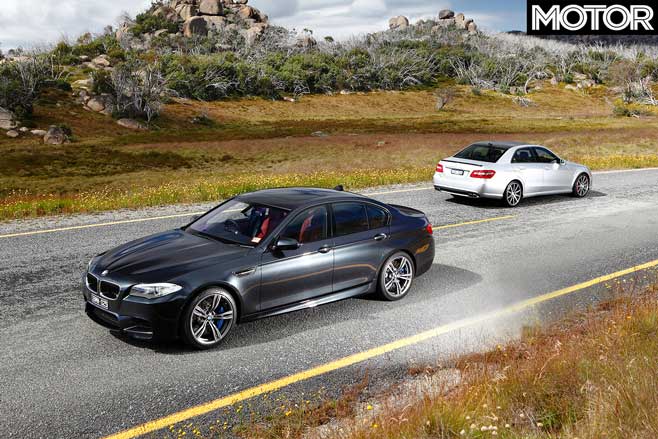
If the M5 is the inside trader, the E63 is the bloke who knocks on your door late at night with a not-so-cryptic message from your loan shark. Overall, we’d say the M5 is definitely the prettier of the two, but some of the detailing on the AMG is extremely well judged, too.
If the E63 looks a bit familiar, it should; the model has been around since 2009 in more or less this visual form. But hoist open that huge bonnet and there’s an all-new heart in there.
That fabulous 6.2-litre atmo V8 is now a memory, replaced by an all-new 5.5-litre V8 lump with twin turbochargers to peg power at 386kW, but bump torque from 630Nm to a full 700 of the buggers. And this one has even more: 410kW courtesy of an optional factory hot-up. With an all-new seven-speed auto on board as well, claimed fuel economy has fallen from 12.7 litres per 100 to just 10 litres.
No, it’s not as tuneful or, at least, as loud as the old atmo jobbie, but it still sounds like a V8 and it still has that AMG trick of allowing you to hear and feel the bass notes while staying free of any audible shrill notes or mechanical thrash.
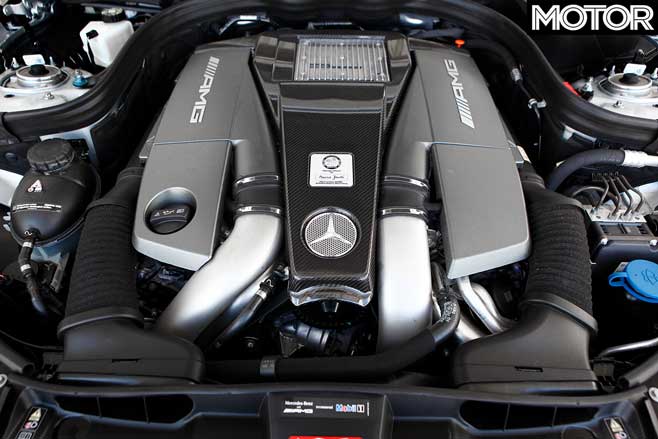
Bimbling around town with everything set for ‘comfort’, the gearbox harnesses all that part-throttle torque to short-shift and take up any slack in the converter. But switch to Sport or Sport Plus and it gets livelier in the gearbox department. Finally, you can switch the tranny to Manual but, just like many-a-conventional auto with a manual mode, it doesn’t necessarily follow your every command. Hustle it into a slower corner on a track, bang the paddle down three times and you might get two gears. Three, obviously, would have been nicer.
No such dramas in the M5 which, with its double-clutch DCT tranny (also with seven forward ratios) remains a more obedient gadget. And like all good, modern double-clutch boxes, the BMW’s shifts smoothly and swiftly and remains civilised, unlike everything else in the supermarket car park on pension day.
With two user-programmable M switches on the tiller, you can pretty much tailor the car to the spec you want it as a one-button job. But unlike the previous car, you don’t have to press either M button to extract the max welly from the engine.
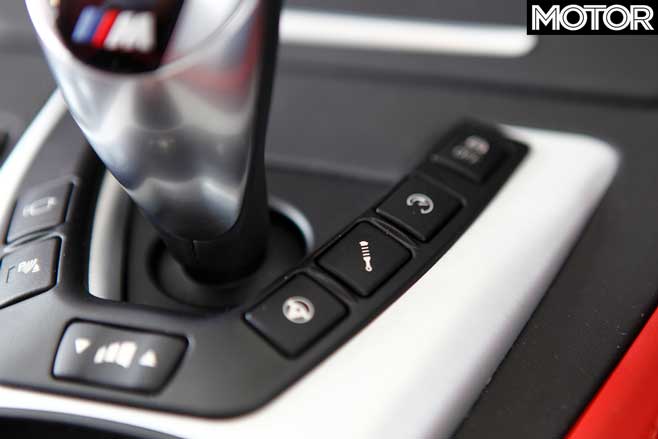
Nope, if it’s running, there’s the full 412kW and 680Nm available from the twin-snail 4.4-litre V8. It’s an interesting mechanical layout, with the exhaust manifold and two turbochargers mounted within the vee of the engine and the induction set-up hanging off the side where the headers would be on a conventional V8.
But what I can’t figure out is why this car felt so different to the M5 I drove in Germany a few weeks ago. The big difference is not in the way it goes, but in the soundtrack. This Aussie car in this test still had the big blurty raspberry on the over-run at high speeds, but it didn’t have the same vocal range across the lower part of the tacho face. Significantly, it lacked entirely the huffing and puffing, fizzing and rasping induction noise of the German car.
Now, this is where things get a bit political. BMW has been a bit coy about this feature of the new M5, but it seems that in order to pass tough Euro noise standards AND give drivers the soundtrack they want, BMW has resorted to what it calls ‘Active Sound Design’, which effectively links the car’s on-board brain to the sound system.
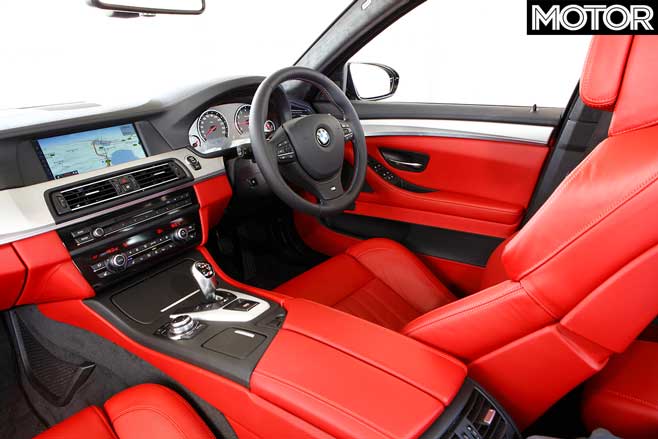
Given that the ECU knows what revs the engine is holding, what load it’s under, the throttle position, what gear it’s in and God-knows-what-else, it can use that info to synthesise a twin-turbo V8 soundtrack and play it through the stereo.
What I’m thinking is that maybe the German car I drove had the Led Zeppelin engine-note chip while Aussie cars – thanks to different buyer profiles – get the Little River Band version. Technologically, it’s certainly possible to provide different levels of synthetic engine note and maybe even offer the same car with various stages of (switchable) ruckus.
BMW engineers shook their heads at this suggestion, however, but one local white-coat admitted that there had been some software changes around December last year. And that would mean that the German car and this car would differ to that extent.
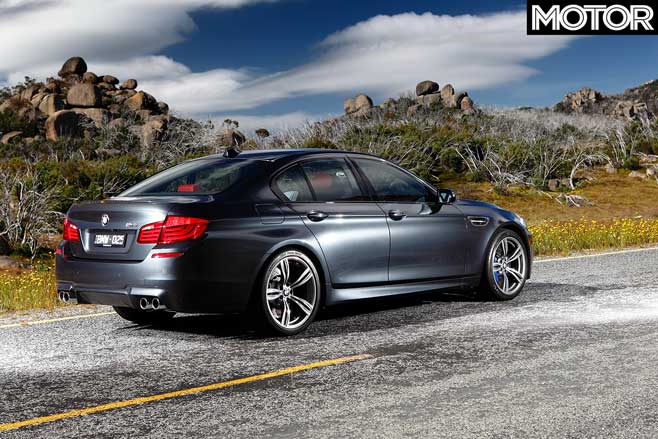
Meanwhile, some people within BMW will tell you the Active Sound Design system is just an amplifier for the engine. My understanding is that it’s more than that; it actually manufactures the noises it thinks you want to hear from such a powerplant. To be honest, I’m not sure how I feel about this. Neither is the rest of the world.
It all depends on how you look at it, I guess. Like (and I’ll stay with the Top 40 metaphor here) were the Pet Shop Boys a red-hot dance act or just a pair of overtly cheerful boys with a drum machine?
Against the stopwatch, 412kW versus the 410 means it’s anybody’s. In the end, though, the AMG turned the standing quarter in 12.4 against the M5’s 12.7. The reason can be seen when you compare 0-100 times: The C63 got there in 4.5 and the M5 took 4.7. And that suggests it’s all in the launch.
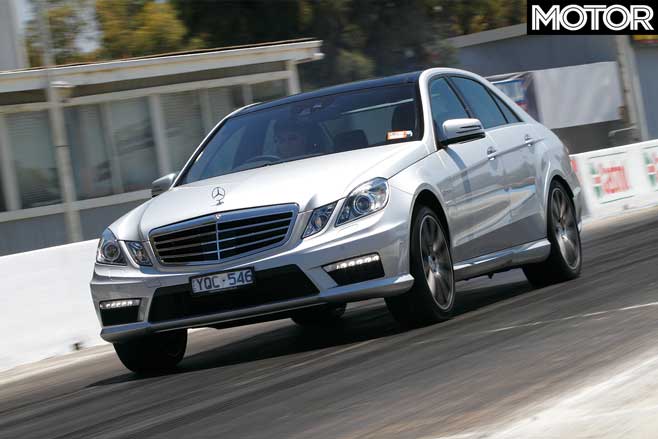
Specifically, the Benz simply has a better (on this day, on this track) launch control set-up. The M5’s launch program can be tailored by using the cruise control buttons to vary the launch revs up and down. The Benz’s is a simple launch-and-hang-on arrangement. Which I would have thought was more or less the point of launch control in the first place. If I need to experiment and fiddle about with launch revs, doesn’t that defeat the purpose of launch control?
That stuff aside, both cars felt incredibly muscular even at the very end of the 400m stretch. Both have enormous top-end thrust and sufficient lack of lag to haze the hides at will from a standing start.
Check the shots of the BMW doing what the backward-cap kiddies would call a power-skid. Actually, what the photo doesn’t show is how bloody hairy it was. As in, I’m still frying the tyres but I’m doing about 120km/h when I realise that if the brute suddenly hooks up, I’m going to be glove-box-deep in the cement wall before you can say ABS.
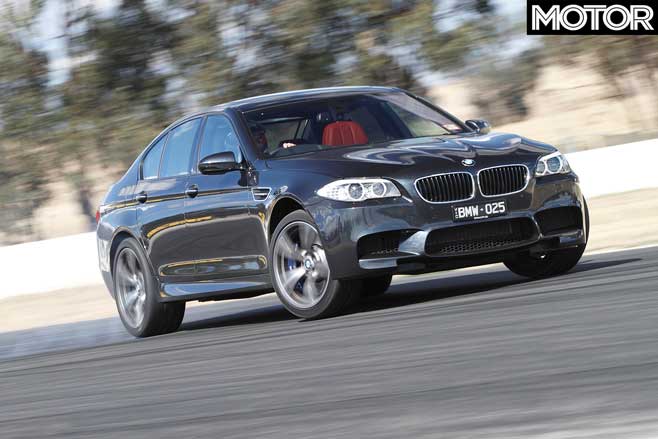
The other drama we had relates (I think) to the BMW’s windscreen that’s coated with something to allow the Head-Up Display to work. Basically, whatever that coating is, it prevented our DriftBox from finding and locking on to its requisite satellites. Fortunately, it has a sunroof with no coating.
Speaking of DriftBoxes and cement walls, things changed dramatically once we hit the Winton circuit in North Central Victoria. Okay, so the BMW was probably always going to be a shade quicker because it’s more track-oriented, but that doesn’t get the Benz off the hook for what happened next.
On a hot but not roasting day (about 32-degrees ambient) the Benz managed to get its engine oil so hot that it went into limp-home mode. Which is not that unusual, but the C63 hadn’t even completed its first hot lap when it all started to melt down.

Obviously, a turbo motor will generate plenty of heat, but a single lap of Winton ain’t that far. And what happens on an autobahn in summer? Okay, so Germany doesn’t get as hot as Winton and there’d be more air going through the radiator and engine bay at 250km/h between Munich and Stuttgart, but even so…
To be fair, the M5 was starting to get warm, too, but only after at least a couple of laps at full noise (synthetic or otherwise). In the end, it recorded a 1.39:9. It’s hard to say exactly, but our figures suggest the C63 would still have been a full second adrift even if it hadn’t coughed and gone sulky on the last corner of the first lap.
The M5’s track superiority is down to a few things. The gearbox is the main one and the DCT’s ability to follow orders is not only endearingly Germanic, it also makes the car quicker because you can set it up into turns more accurately. Knowing that it’ll grab the right gear also makes for one less thing to think about when you have your hands this full.
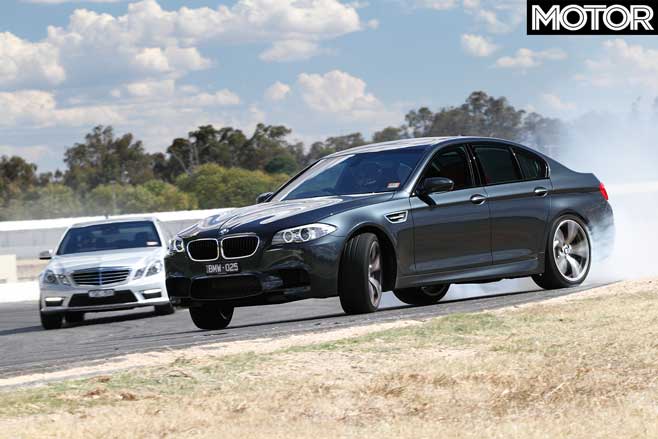
Engine and braking-wise there wasn’t much in it, but in grip terms, the M5 also surged ahead. It’s simply better balanced, less nose-heavy and grippier at both ends.
In normal use, there’s not a whole lot to complain about in either case.
Personally, I find the AMG’s interior a bit more plush, starting with the seats. Benz pews have usually impressed me over the years and the ones in the C63 are no different and actually feel like they’re phased with the suspension. And while the three available settings for the dampers do alter the way the car rides, it isn’t enough to put the chairs off their mission.

The rest of the AMG interior is busy but classy and I’ll include the octagonal tiller in that. It might look like a Stop sign, but the suede bits you hang on to are truly lovely. Only the lack of headroom in the back seat spoils things a little, but it remains a valid observation in a car such as this.
The Benz is the quieter of the two in terms of road noise and the BMW not only has a fraction more tyre roar from those 20s, there was a hint of gearbox whine at around 80km/h on a light throttle, too. For all that, however, the ride doesn’t suffer as badly as you’d imagine from a car riding on 20s as standard, probably thanks to the fact that Michelin doesn’t make Pilot Super Sports as a run-flat. (As it is, you get a can of goo and a pump while the Benz’s 19-inch Pirelli P Zeroes are backed up by a space-saver spare.)
Other bits of the M5 are inspired. The Head-Up Display is well worth the price of admission and the Eye-of-God reversing cameras in each mirror give a display that shows exactly what’s behind and to the side of the car with a processor that’s so fast it’s in true time.
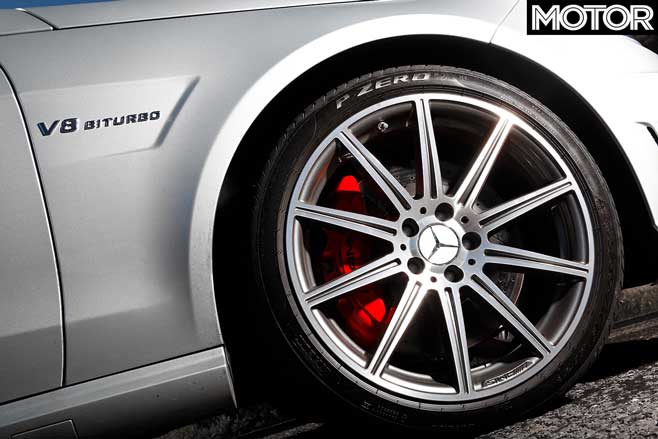
But other stuff I liked less. Like the brake pedal that’s so far to the right it discourages left-foot braking. Why, when evolution has given me two feet, does BMW then supply me with a two-pedal car that must be operated via one foot?
Then there’s the steering feel. Look, I don’t want to make a federal case of this, but the M5’s steering feedback at speed is, without a shadow of a doubt, the most artificial feeling I’ve ever experienced. And don’t go thinking that’s because it’s an electronically-assisted set-up, because it’s not; M-cars still have hydraulic assistance. Either car needs a decent knock to get it off centre (I reckon that’s an autobahn thing) but even at small inputs, the M5’s wheel is abuzz.
So what gives? Beats me, but I’m here to tell you that it honestly feels like a PlayStation with that active-shock-feedback thingy that’s supposed to feel like a real car but absolutely doesn’t. The tiller almost fizzes in your hands but BMW tells me that the M5’s steering system is as unadulterated as Swedish muesli.
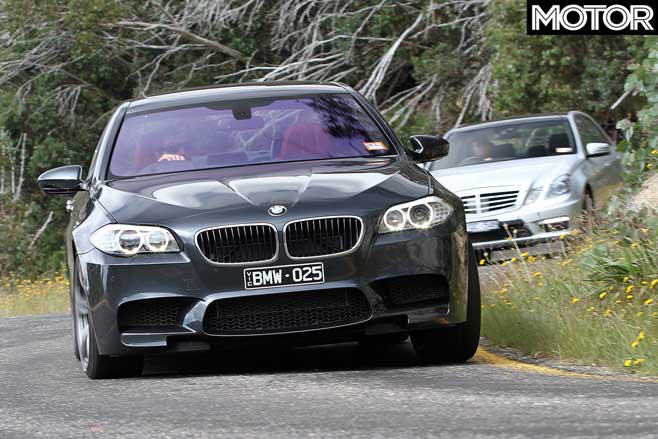
Beyond that, they can’t explain what’s happening. All I can come up with is that the rack bushes are made of granite and that off-centre stiffness (the autobahn thing again) loads up the front end until it feeds back through the column. Dunno. But I can say for certain, I’m not mad about the results. Lots of feedback is one thing, but when it’s the steering-feel equivalent of the canned laughter on an American sitcom, I’m not a fan.
But some people will forgive the M5 that much (and fair enough) but I keep coming back to that synthetic engine note. Like I said, I think one of these cars is having a bit of an identity crisis and by now, you’ve probably guessed it’s the BMW. And while I remain philosophically ambivalent about a synthesised soundtrack, equally I am pretty sure it’s not what the M-badge stands for.
Funny thing is, it’s still a better car than the AMG in some respects, most notably its track performance. But again, I’m left wondering if racetrack smarts is missing the point in a car like this. If you had the $231,370 (dice the soft-close door function and save $900) to buy the M5, wouldn’t you also be likely to have a track-dedicated car for weekend crazy-stuff?
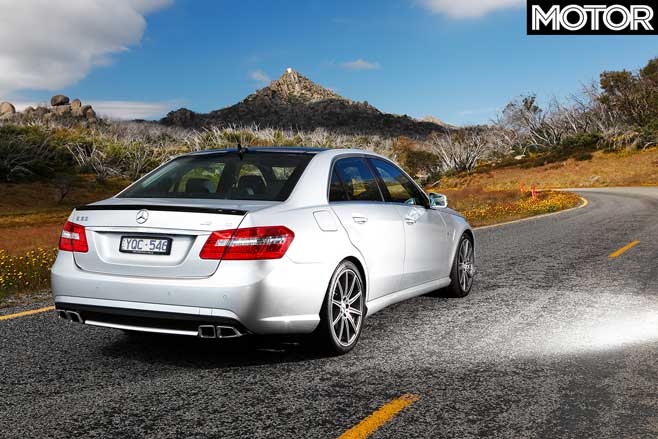
And that’s where the AMG does it for me. It knows what it is, who’s buying it and what features and aspects of its performance will make those punters wrinkle up the corners of their mouths. Oh, and in some respects it kicks the M5’s butt anyway.
But here’s the catch; I’m not entirely sure that a standard C63 would put up such a good fight. See, the list price for the AMG is a substantial $240,985, but as tested, that blew out to a monster $284,130.
How? Well, by the time you add just the Performance Package and the Dynamic Handling Package (and there was plenty more on this car) you’ve added over $31,000 worth of extras. We’re not talking floor mats here, either. Those options (among other things) add the 24kW and 100Nm and the adjustable suspension, so it’s serious gear. And that’s before we even discuss whether an AMG should have handling and performance as options. Again, philosophically, I’m left wondering.
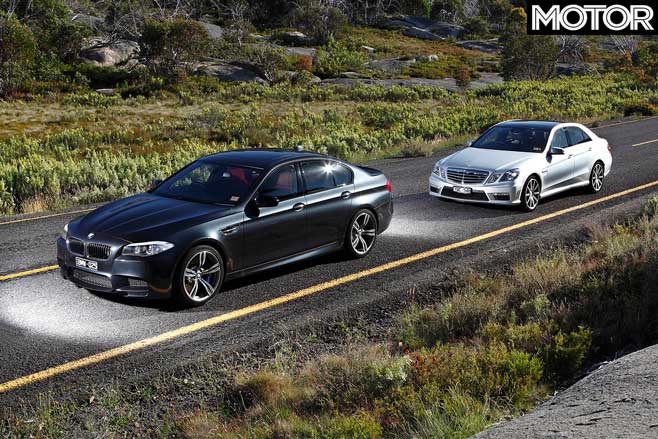
I don’t want to walk into a showroom, point at the most expensive, most potent E-Class in the joint and then be told I have to fork out an extra 40-large to bring it up to speed. But neither do I want to buy a leg-rooter of a V8 supercar only to get it home and discover that the engine note owes more to Stock, Aitken and Waterman than it does to exploding petrol.
And sure, I’m unlikely to be troubled by either scenario but only by financial circumstances. Which begs the question: Am I missing the point of these cars, or are they just not getting me?
And now I’m going to tell you that I actually admire – like, even – both of them. But a winner and a loser? Harder to call. I guess the only real loser is the punter who buys one without test driving the other. Like I said, this stuff is now harder to pick than ever.





